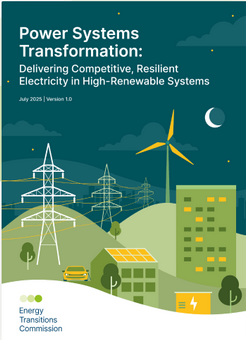The Energy Transitions Commission (ETC) has published a report predicting that global power systems dominated by wind and solar generation can reliably deliver electricity at costs comparable to or lower than today’s fossil fuel-based power systems in most parts of the world.
The Power Systems Transformation: Delivering Competitive, Resilient Electricity in High-Renewable Systems report shows that many countries can operate power systems with 70 per cent or more electricity from wind and solar, using proven technologies available today, like battery storage, other energy storage, long-distance transmission, and flexible energy use.
High wind and solar systems can be competitive with today’s wholesale prices and grid costs. Sun belt countries could see costs more than halve to $30-$40/MWh by 2050. Wind-dependent country costs (e.g., UK) are higher, but in the future could be comparable to current levels. The report also recognises that to 30 per cent of all global power demand could be time-shifted through demand-side flexibility, although this will require the development of dynamic pricing and the use of smart management technologies.
Electricity is projected to provide up to 70 per cent of global final energy consumption in a decarbonised energy system, growing from around 20 per cent today. Total global electricity demand could potentially triple, reaching 90,000TWh by 2050 compared to 30,000TWh today, and be met with new generation predominantly from wind and solar.
‘Sun belt’ countries, including India, Mexico, and much of Africa, are not surprisingly best-positioned to cut power system costs by transitioning to low-cost, solar-led systems, which mainly require day-night balancing.
In contrast, ‘wind belt’ countries – such as the UK, Germany, and Canada, that rely on higher shares of wind face higher balancing costs but can still achieve affordable and stable systems through smart policy and innovation.
In many regions, long-distance transmission lines can be one of the most cost-effective solutions to balancing supply and demand and should be maximised where feasible.
“Multiple technologies, including nuclear and geothermal, may play a role in zero-carbon power systems. But wind and solar will be the dominant source of power in most countries, providing 70 per cent or more of electricity at costs at or below today‘s fossil-based systems. In particular, in the global sun belt, the collapsing cost of solar PV and batteries makes possible far cheaper and more rapid growth in green electricity supply than seemed feasible ten years ago. But wind belt countries can also achieve cost-effective decarbonisation by leading in offshore wind, long-duration storage, and grid innovation.” said Adair Turner, chair of the Energy Transitions Commission.
Generation is, however, pointless without grid development. The ‘last mile’ of decarbonisation will be the most expensive, particularly in countries which need ultra-long duration balancing to meet seasonal variations in supply and demand. Once countries have reached very low levels of carbon intensity (e.g., less than 50g per kWh), electrification is more important than rapid last-mile decarbonisation.
Total global grid length will need to more than double by 2050, reaching around 150–200 million km. Annual grid investment could rise from $370bn in 2024, peaking at $870bn in the 2030s. However, around 35 per cent of grid expansion costs could be avoided between now and 2050 through the usage of innovative grid technologies.
ETC concludes that delivering low-cost, high variable renewable energy power systems will require strategic vision and planning, including market reform to put all technologies on a level playing field, grid modernisation enabled by innovative technologies, supply chain development strategies and customer engagement.
© 2019 Perspective Publishing Privacy & Cookies







Recent Stories